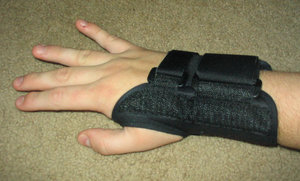Clinical Question: Is local steroid injection for carpal tunnel syndrome as effective as surgery?
Setting: Outpatient (specialty)
Study Design: Randomized controlled trial (nonblinded)
Allocation: Concealed
Synopsis: Adults with carpal tunnel syndrome who were referred to a clinic that specialized in this condition were eligible to participate in this study if they had symptoms for more than three months and did not respond to two weeks of nonsteroidal anti-inflammatory drug therapy and splinting. The authors confirmed the diagnosis of carpal tunnel syndrome by electrodiagnostic testing. Patients were assigned randomly to surgery (n = 80) or local steroid injection (n = 83). One surgeon performed all surgeries and another surgeon gave all steroid injections.
The main outcome--severity of symptoms on a 100-point visual analog scale--was assessed via intention to treat. The authors defined treatment success as a 20 percent reduction in symptoms. This is consistent with other literature that suggests a 15 to 20 percent improvement is the minimum difference that is clinically meaningful. Because more than 80 percent of patients in the steroid injection group received two injections, the therapy in this study should be attributed to a course of two local steroid injections, not a single injection. The patients in each group were similar at baseline, and by the end of the study, more than one fifth of each group had dropped out.
After three months, 94 percent of the patients treated with steroid injections improved compared with 75 percent of the surgical patients (number needed to treat = five; 95 percent confidence interval, three to 13). However, by the end of 12 months, there was no significant difference in improvement between the steroid injection and surgical groups (70 and 75 percent, respectively). The high dropout rate in this study may confound these data.
Bottom Line: Patients with carpal tunnel syndrome do better with local steroid injections than with surgery in the short term. By the end of 12 months, however, the outcomes are comparable, even though more than 20 percent of participants in this study had discontinued treatment. (Level of Evidence: 2b)
Study Reference: Ly-Pen D, et al. Surgical decompression versus local steroid injection in carpal tunnel syndrome: a one-year, prospective, randomized, open, controlled clinical trial. Arthritis Rheum February 2005;52:612-9. Used with permission from Barry H. Steroid injection = surgery for carpal tunnel. Accessed online March 31, 2005, at: http://www.InfoPOEMs.com.
COPYRIGHT 2005 American Academy of Family Physicians
COPYRIGHT 2005 Gale Group



